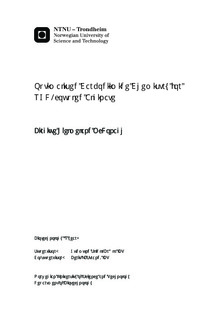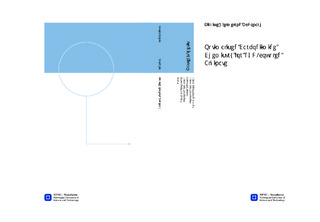| dc.description.abstract | Alginate is a naturally ocurring polyanion of (1→4)linked β-d-mannuronic acid (M)and its C-5 epimer α-l guluronic acid (G). The polyanion, and particularly longstretches of guluronic acids, chelates and form hydrogels in the presence of divalentcations such as Ca2+ . Chelation occur at physiological conditions and the formed hy-drogels are biocompatible and stable. These properties nominates alginate hydrogelsas promising biomaterials in tissue engineering applications. Encapsulation of cells inalginate beads is easily prepared by mixing cells with high molecular weight alginate,and dripping the solution into a CaCl2 solution. When alginate comes into contactwith Ca2+ ions, alginate beads are immediately formed and the cells are captured ina three dimensional alginate matrix. Once inside the alginate capsule, the cells canbe transplanted into a host deficient in the particular cells. The alginate protectsthe cells against the immune system of the host, opening for allograf transplantationwithout immunosuppressiva. The pores in the alginate network are big enough toenable diffusion of waste and nutrition through the membrane, which is importantfor cell survival.Alginate is in itself not cell adhesive. However, alginate can be tailored into a celladhesive biomaterial by attachement of cell adhesive peptides, such as the RGDmotif found in extracellular matrix molecules such as fibronectin. Coupling of celladhesive peptides increase cell survival in three dimensional alginate matrices. Inthis study, RGD-alginate is tailored with a chemoenzymatic approach that ensuresRGD-coupling to non-gelling residues. This procedure starts with non-gelling man-nuronan that is chemically modified by attachement of the cell adhesive peptideGRGDYP by carbodiimide chemistry. Gelling residues are introduced to peptidecoupled mannuronan by a two step epimerisation catalyzed by the epimerases AlgE4and AlgE6.In this study, the carbodiimide chemsitry used for coupling GRGDYP to mannuro-nan is optimalised to create alginate with more than 0.2% bound peptide. Themodel molecules fluoresceinamine, 4-aminophenol and L-tyrosine-methyl ester areused for optimalisation, and the latter model molecule was found to give the bestrepresentation of peptide coupling to mannuronan. The carbodiimide mediated cou-pling to mannuronan is investigated by varying the pH, temperature and reactantconcentrations. The degrees of coupling for each intervention is assessed by 1 H NMRand UV/vis spectroscopy. The presence of covalently bound by-products, namedN-acylurea adducts, to mannuronan is assessed by 1 H NMR spectroscopy and acontrolled reduction of these unwanted compounds is attempted. The results from the optimalisation indicates that coupling of Me-O-Tyr and GRGDYP to mannuro-nan is concentration-dependent, as an increase in coupling was observed when theGRGDYP and Me-O-Tyr concentrations was increased. The highest peptide incor-poration described in this study was 3.4% GRGDYP coupled to mannuronan, whichis higher compared to similar studies.The optimalised carbodiimide chemistry is applied to a large scale batch of RGD-coupled alginate that is to be used for cell encapsulation of olfactory ensheating cellsfrom neonatal rat brain.High molecular weight alginate was coupled with 0.45% GRGDYP and filtratedwith active coal before cell encapsulation. The coal filtration removed a substantialamount of the unwanted N-acylurea adducts but also removed peptides, resultingin a GRGDYP coupling of 0.1% calculated from UV/vis spectroscopy, and 0.4%calculated from 1 H NMR spectroscopy. This indicates that peptides are associatedwith N-acylurea adducts and that active coal filtration is necessary to remove them.Encapsulation of olfactory ensheating cells to RGD-coupled alginate gave no mor-phology changes or enhanced cell viability compared to non-peptide coupled alginate.It is believed that the low enzymatic action of the AlgE6 epimerase, a low concen-tration of peptides or a combination of both, have influenced the cell viability andlack of morphology changes. Enhanced peptide incorporation can be achieved byincreasing the reactant concentrations of the peptides, but this would lead to a moreexpensive procedure. Increased efficacy, meaning a higher peptide coupling withlower adduct formation, at lower peptide concentrations was not achieved. However,the use of sodium borohydride in combination with periodate oxidised alginates forpeptide coupling should be assessed as a novel approach for increased peptide yieldsat lower peptide concentrations. | nb_NO |

